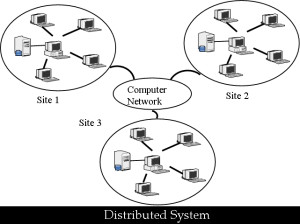In this article we are going to have a detail discussion on what is distributed system and distributed Operating System.
Distributed System-
Three generation of Distributed System are-
1) Early Distributed System– This system emerged due to the use of Local Area Network technologies. It had limited support for services and consisted of 10 to 100 nodes. All these nodes were connected by LAN. It was used on a small scale and emerged in late 1970s and early 1980s hence was also known as Early Distributed System.
2) Internet-Scale Distributed System– This system emerged in 1990s and it covered larger scale than Early Distributed System but smaller than Contemporary Distributed System.
3) Contemporary Distributed System– It is ultra large scale distributed system. It is complex system and consist of number of smaller subsystem.
Communicating Entities In distributed system- Processes are used for communication in distributed system. Inter process communication, remote invocation, indirect communication are used as communicating paradigms. Remote invocation takes place between sender and receiver. In this method receiver is aware of the sender who is sending message. Indirect communication consist of group communication, publish-subscribe system and message queue.
Group communication-In group communication message is sent to set of recipients.
Publish-subscribe system– In this system a large number of producer produces message and this message is sent to number of consumer who will consume message.
Message queue– In this type producer produces the message and is sent to specified queue. Then consumer can receive message from this queue.
Distributed Operating System is a model where computer application are running on a set of computers that are interconnected by network.
Problems and Threats in distributed system- Threats in distributed system are attacks that may include the most common attack which is Denial of Service attack.
Problems that the distributed system has to face is–
1) Some parts of system are more used in comparison with the other parts in the system hence this increases the work load on them which are more used while the other parts remain idle.
2) Some parts of system may get disconnected this may stop communication among the system.
Distributed Operating System-
Distributed Operating System manages the Distributed system. Distributed Operating System is an architecture in which distributed application are running on a set of computers that are interconnected by network. These are loosely coupled system which means they have no hardware connection at CPU level. Distributed OS communicate with each other with LAN or WAN technology and also allows for various resource sharing. In distributed OS the user does not know on which machine their files are stored or on which machine their program is running. Process management needs to be done in this type of system for efficient sharing of resources. For example load balancing is an example of process management in which performance of each node is monitored.
Distributed system has higher reliability than centralized system. This is because system is not dependent on a single instance but is dependent on multiple instances. Hence when failure occurs in some part of system the other parts can continue their operation without being interrupted. As number of instances are involved in performing a particular task hence computation speed is also increased.
